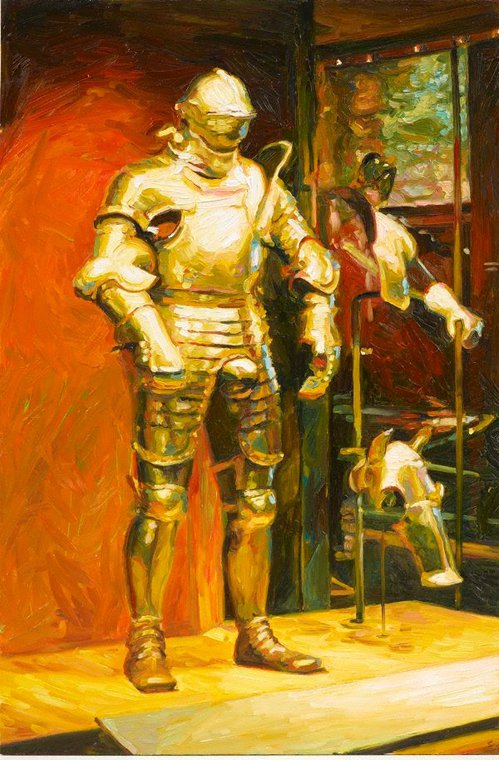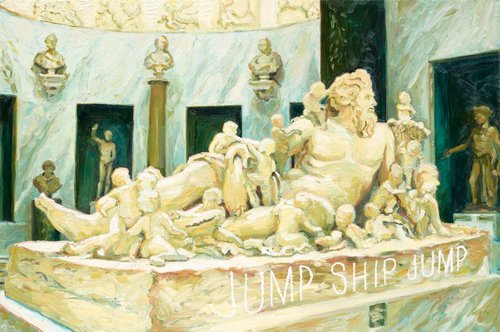-
Details
- Date
- 2008
- Media category
- Painting
- Materials used
- oil on board
- Dimensions
- 60.0 x 40.0 cm
- Credit
- Viktoria Marinov Bequest 2010
- Location
- Not on display
- Accession number
- 130.2010
- Copyright
- © Julie Fragar
- Artist information
-
Julie Fragar
Works in the collection
- Share
-
-
About
Julie Fragar is engaged in painting what Charles Baudelaire described as the ‘fantastic reality of life’ in works that are usually small, diaristic and intimate.1 Often worked up from snapshot photographs, her subject matter is her partner and children, other family members, friends, her social and cultural milieu, and herself. While tracing an analogy between Baudelaire in 19th-century Paris and Fragar in contemporary Brisbane may seem to be drawing a long bow, a link may be found in Fragar’s interest in the work of Baudelaire’s contemporary, Gustave Courbet. Working from reproductions in books, Fragar has ‘sought the advice’ of Courbet through painting his paintings; learning by doing cover versions in her own small-scale, quickly executed works such as ‘The sculptor made quite a good woman (get up)’ 2008. 2
Fragar exhibits her delightful pastiches of Courbet’s figure subjects alongside her own contemporary scenes, suggesting continuity with the history of realism in art. In recent years Fragar has often painted the men that she knows, an ‘other’ that is close to hand. From sensitive scenes of her partner with their children to a confronting recent series of a hunter with his kill, these depictions accumulate into an image and experience of masculinity observed by a woman intimately linked to the men pictured. In addition to her version of a Courbet, this particular grouping of works includes other paintings of the cultural past including classical sculpture and a suit of armour, and contemporary subjects such as her shirtless brother and cousins walking across a beach and a self-portrait looking at a book of Marlene Dumas’s paintings of naked aroused men.
Fragar often uses text, not only in ‘pure’ text works as but also in others in which her painted surfaces have words melded into or painted over images. ‘THISPATHHOLDSNOPOSSIBILITYOFVICTORY’ 2009 is typical of those which consist entirely of text laid out to fit the canvas with all the breaks within words that this may result in, across which the viewer’s eye stutters and deciphers as we literally read the paint and the painting for meaning. Fragar usually displays her works in groupings, including the text paintings with more straightforward images. Her realist scenes are also interspersed with more deliberately fragmented images, overlaid with child-like drawings or with secondary images as in ‘Lie to me’ 2008, or with a ghosted shattering of the painting depicted in the work itself. Exhibited together they do not allow the assumption of an unmediated access to what is depicted, even in images that seem to most closely record autobiographical moments.
1. Charles Baudelaire, ‘The painter of modern life’, in P E Charvet (trans), ‘Baudelaire: selected writings on art and artists’, Cambridge University Press, Cambridge 1981, p 406
2. Francis Parker writes: ‘Fragar speaks of “asking for advice” from this long-dead painter’. See Francis Parker, ‘The salon project: a chamber of light and dark’, in ‘Contemporary Australia: optimism’ (ex cat), Queensland Art Gallery, Brisbane 2008, p 195 -
Exhibition history
Shown in 2 exhibitions
Contemporary Australia: optimism, Queensland Art Gallery/Gallery of Modern Art, Brisbane, 15 Nov 2008–22 Feb 2009
Primavera 2010, Museum of Contemporary Art, Australia, 19 Aug 2010–20 Nov 2010
Primavera 2010, Queensland University of Technology Art Museum, Brisbane, 04 Feb 2011–03 Apr 2011




